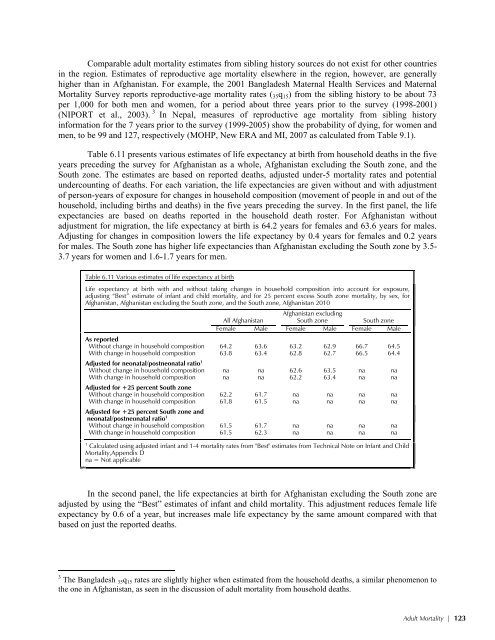Afghanistan Mortality Survey 2010 - Measure DHS
Afghanistan Mortality Survey 2010 - Measure DHS
Afghanistan Mortality Survey 2010 - Measure DHS
- No tags were found...
Create successful ePaper yourself
Turn your PDF publications into a flip-book with our unique Google optimized e-Paper software.
Comparable adult mortality estimates from sibling history sources do not exist for other countriesin the region. Estimates of reproductive age mortality elsewhere in the region, however, are generallyhigher than in <strong>Afghanistan</strong>. For example, the 2001 Bangladesh Maternal Health Services and Maternal<strong>Mortality</strong> <strong>Survey</strong> reports reproductive-age mortality rates ( 35 q 15 ) from the sibling history to be about 73per 1,000 for both men and women, for a period about three years prior to the survey (1998-2001)(NIPORT et al., 2003). 3 In Nepal, measures of reproductive age mortality from sibling historyinformation for the 7 years prior to the survey (1999-2005) show the probability of dying, for women andmen, to be 99 and 127, respectively (MOHP, New ERA and MI, 2007 as calculated from Table 9.1).Table 6.11 presents various estimates of life expectancy at birth from household deaths in the fiveyears preceding the survey for <strong>Afghanistan</strong> as a whole, <strong>Afghanistan</strong> excluding the South zone, and theSouth zone. The estimates are based on reported deaths, adjusted under-5 mortality rates and potentialundercounting of deaths. For each variation, the life expectancies are given without and with adjustmentof person-years of exposure for changes in household composition (movement of people in and out of thehousehold, including births and deaths) in the five years preceding the survey. In the first panel, the lifeexpectancies are based on deaths reported in the household death roster. For <strong>Afghanistan</strong> withoutadjustment for migration, the life expectancy at birth is 64.2 years for females and 63.6 years for males.Adjusting for changes in composition lowers the life expectancy by 0.4 years for females and 0.2 yearsfor males. The South zone has higher life expectancies than <strong>Afghanistan</strong> excluding the South zone by 3.5-3.7 years for women and 1.6-1.7 years for men.Table 6.11 Various estimates of life expectancy at birthLife expectancy at birth with and without taking changes in household composition into account for exposure,adjusting “Best” estimate of infant and child mortality, and for 25 percent excess South zone mortality, by sex, for<strong>Afghanistan</strong>, <strong>Afghanistan</strong> excluding the South zone, and the South zone, <strong>Afghanistan</strong> <strong>2010</strong><strong>Afghanistan</strong> excludingAll <strong>Afghanistan</strong>South zoneSouth zoneFemale Male Female Male Female MaleAs reportedWithout change in household composition 64.2 63.6 63.2 62.9 66.7 64.5With change in household composition 63.8 63.4 62.8 62.7 66.5 64.4Adjusted for neonatal/postneonatal ratio 1Without change in household composition na na 62.6 63.5 na naWith change in household composition na na 62.2 63.4 na naAdjusted for +25 percent South zoneWithout change in household composition 62.2 61.7 na na na naWith change in household composition 61.8 61.5 na na na naAdjusted for +25 percent South zone andneonatal/postneonatal ratio 1Without change in household composition 61.5 61.7 na na na naWith change in household composition 61.5 62.3 na na na na1Calculated using adjusted infant and 1-4 mortality rates from "Best" estimates from Technical Note on Infant and Child<strong>Mortality</strong>,Appendix Dna = Not applicableIn the second panel, the life expectancies at birth for <strong>Afghanistan</strong> excluding the South zone areadjusted by using the “Best” estimates of infant and child mortality. This adjustment reduces female lifeexpectancy by 0.6 of a year, but increases male life expectancy by the same amount compared with thatbased on just the reported deaths.3 The Bangladesh 35 q 15 rates are slightly higher when estimated from the household deaths, a similar phenomenon tothe one in <strong>Afghanistan</strong>, as seen in the discussion of adult mortality from household deaths.Adult <strong>Mortality</strong> | 123








![Obtaining Informed Consent for HIV Testing [QRS4] - Measure DHS](https://img.yumpu.com/49850117/1/190x245/obtaining-informed-consent-for-hiv-testing-qrs4-measure-dhs.jpg?quality=85)








